Another Land Across the Border…
Prelude:
Sometimes I feel I am truly blessed. I have had an opportunity to visit places probably very few people get to venture into. Those were days when I’d travel extensively in North East India. I have always been highly fascinated by the culture of Manipur – both Maitei and the tribal heritage. However, some of my favourite moments in Manipur would be my visits to Moreh and crossing over to Tamu in Myanmar.
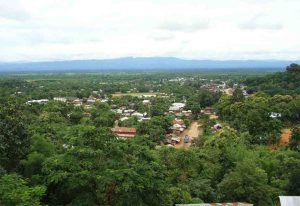
Moreh town in Manipur Photo courtesy: http://www.morehonline.webs.com/
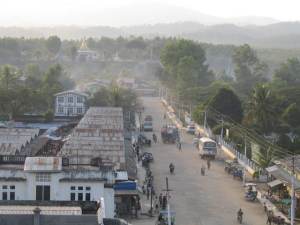
Tamu town in Burma bordering Manipur Photo Courtesy: http://www.tongsan.org/featured-articles/367-zogam-leitang-ngah-kik-ma-teng.html
It was in November of 2010 that Aung San Suu Kyi was released from house arrest after 15 years, by Myanmar authorities. That was a day I rejoiced and decided the theme of my next article. A plethora of memories gushed through my mind. Manipur happens to be one hell of a fascinating state. However, my visits to this state would be incomplete had it not been for the opportunity to cross over to border town Tamu in Myanmar – to meet some of the most amazing people on earth, and, of course, having my Khauk Swe and Mohinga. I have had a zillion memorable experiences while travelling through the green valley embracing the peace that the air there gives you.
A montage of images appear in my mind as I think of Burma or Myanmar – a country that shares its borders with four states of India viz. Arunachal Pradesh, Mizoram, Manipur and Nagaland. I remember Bose’s journey, I am reminded the fact that the oldest school of Buddhism – Theravada is followed by a majority of the people there, the ironic of Buddhist principles – the military junta and a determined woman who stands strong for democracy – Suu Kyi. I got a chance to meet her husband Michael Aris – a renowned Tibetologist of his time during his visit to India several years back. Our encounter naturally revolved around the struggle for a democratic Myanmar. He was well versed, highly knowledgeable about Buddhist philosophy and Himalayan culture.
In the introduction to the collection of essays of Aung San Suu Kyi ‘Freedom from Fear’ , Michael Aris tells the readers, “ She never for a minute forgot that she was the daughter of Burma’s national hero, Aung San…Suu, who was born on 19 June 1945, has only the dimmest recollections of her father. However, everything she has learned about him inclined her to believe in his selfless courage and his vision of a free and democratic Burma…
…Suu wrote to me these words: Sometimes I am beset by fears that circumstances and national considerations might tear us apart just when we are so happy in each other that separation would be a torment. And yet such fears are so futile and inconsequential: if we love and cherish each other as much as we can while we can, I am sure love and compassion will triumph in the end.”
Between Aung San Suu Kyi’s house arrest and Michael Aris’s death, the couple met just five times. Their children’s Burmese visas were deemed invalid and later cancelled. The little family unit could see the military junta’s effort to break Suu Kyi’s spirit by separating her from her children and her husband. But they stood by each other in spirit even though separated by continents. I find it hard to fathom – such relationships. How important nationalist struggles become and personal sacrifices leaders make. I truly hope these sacrifices see the positive light at the end of the day. Though I get crippled in my mind sometimes to see how insignificant humanly concepts are when it comes to the larger context of the universe. Earth is too small in the framework of the universe.
Getting Back to Food:
Red meat is not bad for you. Now blue-green meat, that’s bad for you! -Tommy Smothers
Food brings laughter and humour to my life; I sincerely believe it should bring to other people’s lives as well. People do not just deserve to eat, but to eat well. And there is no denying the fact that there are millions who do not get sufficient food to eat – but at the same time, the most interesting food stories sometimes emerge out of a small hut in a Koliwara village in Mumbai or a make shift arrangement of a ‘home’ of the ghadiya lohars on the streets of Delhi.
There are many people I observe, for whom food is a formality or an unavoidable day-to-day necessity. For me, it is an experience. It is a way of knowing the pulse of a people. It is a way of life. For me, it has non negligible anthropological significance.
Why do I connect with Burmese Food?
Burmese food is one of my favourites. Even in Delhi I ensure that my quota of Burmese food is well catered to through a small shop in Vikaspuri. And who would believe me if I said, it is run by a Sardar ji? Well, I am attesting my evidence with this article.
Kiran Kollections is a quaint shop in Vikaspuri. This shop caters to a small Burmese migrant population in Delhi and of course eternal food mongers like me. It has Moe Sabei sunflower seeds, Jun Hua readymade soup, Yum Yum instant noodle, Ah Yee Taung-pickled tea, fried garlic and beans and raw materials like rice noodles, and many more things, all manufactured in Burma. Whenever I am in that part of town, I can’t resist myself to buy my Burmese tuck for the month! In northeast, especially in Nagaland, Mizoram and Manipur, these products are flooding the market, of course.
Every year, the migrant Burmese population in Delhi gets together to celebrate a food festival and relive their culture in this region. This year I met a very special person during this festival. I shall come to that later. But before that, let’s delve a little deeper into Burmese cuisine – its influences and practices.
Food, People, their Customs and Memories:
Mango among fruits, pork among meats, tea among leaves (are the best) – Old Burmese proverb
Burma is an agrarian country and most of the ingredients of their cuisine are fresh. The country gets a massive fragment of its culinary tradition from India and China. However, they have managed to create their own identity of cuisine in a cultural context. With the gradual advent of Islam and Buddhism, beef and pork has a mixed reception in present Burma. While the Muslim population does not eat pork, the Buddhist population abstains from beef.
Traditionally, the Burmese would have low sitting arrangements for dining. Their food would be served to the senior most on the table and then served to others. If you leave a little food on your plate, it will be assumed that you need a second helping.
Some of the popular Burmese snacks Ah Kyaw or assorted fries, Bein Mont or Rice pancake, Mont Sein Paung or steamed rice cake. Though these are sweet snacks, the sugar level in each of them is quite mild. Hence, those friends of mine who do not have a sweet tooth enjoy these snacks a lot. The Burmese also prepare a special rice dumpling called Mont Lone Gyi.
The Burmese people do not have a tradition of having any drink along with food. Most people do not even take any water during meals. Hence, I am forced to believe that soups are indispensible components of food, for the same reason. Snacks are mostly prepared from glutinous rice, milk and shredded coconut. Many of their dishes will be accompanied by a black bean paste which is the fermented soya bean popular in India’s north east as well. Also, ngapi – a shrimp paste is highly popular.
The main dish usually consists of a meat or a fish preparation, vegetables or salads and some kind of soup. They prepare a lot of sea food like fish and prawn, while in eats chicken, duck, pork and mutton is popular. Beef is not that common except for the Muslim population which relishes it.
S-a-r-a-h: Something interesting happened this year. I meet a very beautiful soul called Sarah. Her father with whom she shared a very special bonding passed away two years back. Interestingly, he was Burmese and was a very
spirited soul himself, not to mention a dynamic life. He escaped Burma in the early eighties right through the revolution and was en route to Canada when he met her mother in India and, of course fell madly in love. The journey to Canada never happened. Instead, he stayed over all his life in the metro city I love the most – then Calcutta.
Though a citizen of the universe herself, Sarah’s Burmese connect made me prepare Ohn No Khao Suey for her in the memory of her father, on his birthday this year. I was glad she not only relished it, but thought it did justice to her beloved father’s memories.
Ohn Noh Khauk Swe: It is a soupy noodle dish staple of Burma. One rendition called Khao Soi is also served in Thailand and Laos. Ohn Noh Khauk Swe is what is the authentic Burmese Khauk Swe and is an easy preparation. First you prepare a broth with coconut milk base and gram flour to thicken it in meat stock. You boil Burmese Khauk Swe rice noodles and keep it aside. Remember not to over boil it. Then serve the soup and the noodles with an array of condiments. The list is given below:
Chopped Hard Boiled eggs
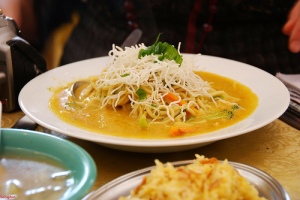
Ohn No Khauk Swe Photo Courtesy http://www.flickr.com/photos/bellaphon/3554783895/
Chopped Deep Fried onions
Chopped Roasted Fried garlic
Chopped Spring onions
Chopped Green Chillies
Chopped fried meat pieces
Fish sauce
Roasted Chillie flakes
Lemon Juice
People keep experimenting with these condiments, but more or less, these are the basic condiments used. One has to put all these things together and to savour the flavour of the Burmese Ohn Noh Khauk Swe
Mr. S-a-w: Eighty year ‘young’ Saw is the epitome of spirit. He is a Burmese living in India since the sixties. I met him during the Burmese Festival this year held in Vikaspuri while relishing one of his favourite Burmese dishes – Mohinga. It is a dish prepared from rice noodles mixed in fish soup.
Mr. Saw had been to Burma only twice since he stepped on the Indian soil. He was rather surprised when he learned that I have been to Myanmar at least twelve times.
When I asked him if he wanted to go back, he was rather sure that he would not. Forty five years is a long time. India had become his home and was in his heart.
S-a-b-i-n-a: I have beautiful memories of people enjoying the Khauk Swe that I prepare at home; one of them being Sabina (Sehgal Saikia). Every time I prepare the dish, the memories of her calling me up an ‘ordering’ me to treat her with a Khao Swe lunch come back with utmost clarity. She would eat the dish and relish it so much that it would be a sheer pleasure to simply watch her. She had written the foreword for my cookbook NE Belly. We also had this non-northeastern-northeastern bonding —well, that’s a different story altogether. I truly miss this foodie buddy I could so much relate to – I can only pray for the peace of her soul.
End word in Folklore:
Roger Bischoffe, a scholar of Buddhist studies has written a paper called Buddhism in Myanmar – a short history. There he writes about four dominant ethnic groups in Burma primarily – the Mon, the Pyu, the Myanmar and the Shan. A lot of migration took place from India towards Burma and vice versa. G.E. Harvey, in his History of Burma, relates a Mon legend which refers to the Mon fighting Hindu strangers who had come back to re-conquer the country that had formerly belonged to them.This Mon tale confirms the theory that Indian people had formed the first communities in the region but that these were eventually replaced by the Mon with the development of their own civilization. As well as the Indian trading settlements, there were also some Pyu settlements, particularly in the area of Prome where a flourishing civilization later developed. It is also believed that the original name of Burma was ‘pyi htaung zu bama naingan daw’ which also stands for ‘one thousand countries united into a royal Burma.
Burmese culture is full of legends, mystical stories and folklores. I am putting here a Burmese folklore that sums up purpose of our lives in some way. It is a version retold by Margaret read McDonald and I have taken the version from the internet. It is called A Kingdom Lost for a Drop of Honey.
The King and his Advisor sit at the palace window eating breakfast and looking down on the street below. A drop of honey falls on the windowsill. He tells Advisor not to clean it up, servants will do it later. “It’s not our problem.” The drop of honey slides down the windowsill plopping onto the street below. A fly lands on the honey, a gecko springs out to swallow the fly, a cat sees the gecko and pounces and finally a dog attacks the cat. The alarm goes out about the fight, King says, “It’s not our problem.” Cat’s owner beats the dog, dog’s owner beats the cat, soon are beating each other. Friends of each man gather to cheer the combatants on; soon everyone is fighting in the street. King: “It’s not our problem.” Soldiers arrive, try to break up the fight, but begin taking sides and soon join the fight. It erupts into a civil war. Houses burned, people killed, palace set on fire and burned to the ground. King: “Perhaps I was wrong. Perhaps that drop of honey WAS our problem.”
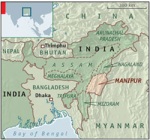

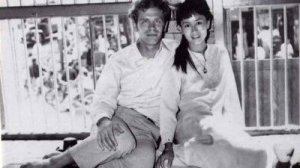
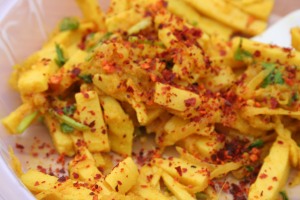
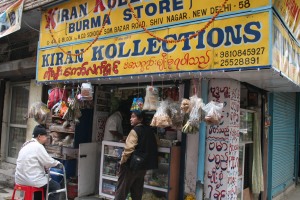

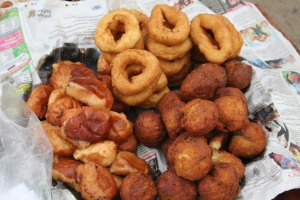
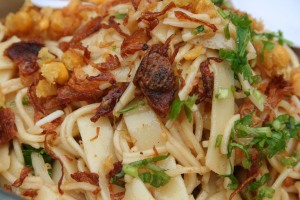
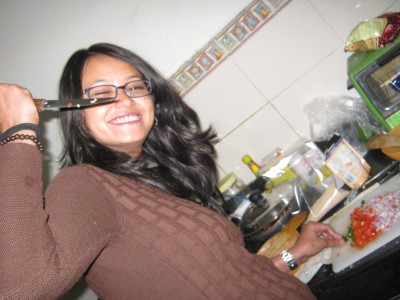
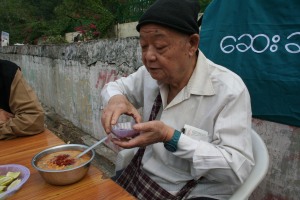

March 20, 2011 at 12:52 pm
Hi Ashish.I glad to see a post from you after along time.Interesting story as usual.Cheers
March 20, 2011 at 1:39 pm
if we love and cherish each other as much as we can while we can, I am sure love and compassion will triumph in the end.”
This my fav. line from yur article and i see n feel what you say..
your fondness of bringing pple and food together is amazingly a wonderful instrument.I am blessed to have met, ate and laugh with you…
kudos to you Ash!!!
March 20, 2011 at 1:57 pm
Thank you Gugu –at the end of the day we come empty handed and go empty handed and if we can share a good meal and a great laugh together our existence becomes meaningful.Glad you enjoyed your meal with us
March 20, 2011 at 6:12 pm
I like your blog.It is very informative and your articles make a facinating read.All the best
March 21, 2011 at 1:09 am
I am based out of Uk and my mother was from Mandalay in Burma.Your article reminds me of her.Thank you for reminding me of her.She use to prepare the most awesome Mohinga.Do continue write such articles
March 21, 2011 at 12:51 pm
Hi Ash .. That was a beautiful journey … Never before the emotional side gastronomy was put so beautifully until this piece. I never tasted Khauk Swe but reading your blog I could actually smell and taste it…… Unlike Jhonny Walker would say “Keep Eating”
March 21, 2011 at 4:17 pm
hi I am Bharti from kolkota.I just stumbled upon your blog while searching for info on burmese food.I compliment you on the way you evolve food around people and history.Your posts are indeed worth a read..By the way I know Sarah.
March 22, 2011 at 2:28 am
Very well written Ashish.Your historical and culinary journeys are engrossing.Best wishes and thanks for sending me the link to your blog
March 22, 2011 at 12:40 pm
Where there is food and people there is ashish.Great blog my friend.bestest
March 24, 2011 at 5:10 am
Readable and engrossing blog and interesting articles of food,people and culture
March 25, 2011 at 11:20 am
Fascinating! I’m definitely coming back for more!
March 26, 2011 at 7:13 am
good and informative site.interesting facts and stories.well done
March 26, 2011 at 9:02 am
I grew up on Mohinga, Laphe Tauk, Phande Khow Swe and the distinct burmese conduct that surrounds food and eating. And then i moved to Delhi and for some time forgot my origins.
Your post. the quality of writing, the knowledge element and your narrative style all come together to evoke my past. It never happens if the writer is ill informed or is bad at writing. Simply proves how well you know the subject and how much you love food and everything about food.
Dr. Chopra, you make me wonder” oh, how much can one man know?”…please continue writing. You dazzle us with your brilliance.
March 26, 2011 at 9:39 am
Thank you Cyril .You still owe me a biryani meal and by the way your film has recieved raved reviews from a well known critic.
March 30, 2011 at 2:53 am
Behind this sweet roly poly figure stands this tall figure.Your vast knowlege of food , culture and philosophy truely zaps me.Tiger camp-thank you for introducing this charming man to me
March 31, 2011 at 5:24 am
Read your latest culinary experience and must say it enlightened me as usual. Though, Burma is my neighbouring country, never had the opportunity to actually relish their cuisine. Just ate for the sake of eating. You taught me that ‘eating is an art in itself’. Hats off to you. Your tireless efforts in whatever you do has always inspired me. Hope this year I can satisfy my gastronomical cravings with your home-cooked meals especially the french omellete.
April 8, 2011 at 4:40 pm
terrific ashish. well written. too bad that i didn’t get a chance to join you when you had invited me along to this place !!
April 13, 2011 at 6:02 am
hey Ashish Bapi here.great stuff.love it.explictly explained
July 27, 2011 at 9:20 am
Hi Ashish….Lovely blog and this article for sure is gr8….enjoyed reading every bit of it. Would plan a trip to Myanmar soon ex – Manipur, heard about the bus trip which is going to start soon from Moreh to Mandalay…..would love to ride that if and when it happens.
September 19, 2011 at 10:46 am
ITS AWASOME STORY ,MY MOTHER WHO WAS BORN AND BROUGHT UP,AND WAS VERY HAPPY TO KNOW ABOUT IT ,THAT SUCH THINGS ARE THERE IN DELHI.PLEASE LET US KNOW THE PHONE NO OF SHOP ‘KIRAN KOLLECTION’ IN VIKASPURI.SANGITA,SEP 19 2011.
January 5, 2012 at 10:35 pm
Great write up Would love to make a trip
February 16, 2012 at 6:03 pm
Thank you Sangita
May 30, 2012 at 12:34 pm
Lovely post Ashish. Quick question, now that I’m so intrigued. You said there’s a Burmese food festival in Delhi every year in Vikaspuri? Where in Vikaspuri and how does one get there? Am i too late to catch it this year?
February 1, 2013 at 12:48 pm
Hello There. I found your blog using msn. This
is a very well written article. I will make sure to bookmark it and come back
to read more of your useful information. Thanks for the post.
I’ll definitely comeback.
July 12, 2013 at 6:59 am
What a lovely writeup. Learned something new today. I’ll definitely drop in at KK whenever I’m around Vikaspuri.
October 14, 2014 at 1:28 pm
thought provoking.
December 5, 2015 at 1:47 pm
i like to eat burmees food can suggest some place in delhi